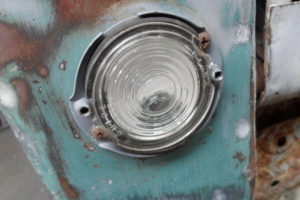My neighbor came to me and told me he had hit something on the freeway late at night. With his car being so low, it was sure to do some damage. He had taken it up the street to a car dealer and he had bought it from and they told him that it was out of transmission fluid. They said it could be the transmission pan or the case of the transmission itself.
They mentioned about $200 t0 $400. Since he is still a college student he was very worried about spending that large amount of money at this time and was wondering if I could do anything to help. I told him would have to crawl under there and assess it myself and if it was the transmission pan I could help him. Just by looking under the car I could see the pan was not damaged in the accident. So I brought over my digital inspection camera to get a closer look around the mounting bolts and areas of the pan I could not see. Then I also plugged in my computer scan tool and turned on the ignition and it gave me the scan number P0746 – which means – fault in the pressure control solenoid, pressure control solenoid #A.
And what this means is the transmission is empty of transmission fluid and all we have to do is assess where the leak is coming from and top it off with new transmission fluid. But now the fun really begins! We go back and get a tow vehicle and we tow it our place. Let’s get this car up in the air and get to work!

Right, Rear Wheel with Chocks.
First, I know I have to get the left front wheel up in the air because the transmission pan is on the driver’s side and that’s where most of my work will be done today. I get a pair of my wheel chocks and block the rear wheel.
Then I go to the front, get my floor jack into position and behind the left front wheel at just the right place on this car, it’s right where the front steel frame bolts to the body of the car. I get it up in the air, then I get a jack-stand in the right place right behind the left front wheel under the lower A-arm. Once that is all done I can safely get under the car.

Proper placement of floor jack & jack stand.
I get my flashlight under the car and finally get a closer look at the transmission pan and my pan bolts are 10mm so I grab me a 10mm socket on a 3/8-inch drive and see if any of my bolts will turn and they do have almost a quarter turn out of each one. After doing that, I grabbed me a shop towel and wiped down the whole pan, wiping all the transmission fluid off so after we are finished with adding new fluid, we will be able to tell if the fluid was coming from the pan. Looking around the transmission of any other possibilities of where the fluid may have come from and could not find any other suspects at this time.








Now, what we do next is lower the car and find where to put in new fluid. We have to remove the air filter box and everything else attached to it. I was hoping that maybe it would have been easy that it may have been a dip stick tube or it would be easily marked. But OF COURSE! It was not! More like a needle in a haystack!!!

Transmission pan drain plug.
We did eventually find it. It was a screw in plug just like the drain plug on your engine oil pan or the transmission pan on this car. I used a star bit on a 3/8 drive to loosen it, take it out. But be careful when you take it out it has a little metal washer on it and this little plug is in a VERY TIGHT spot. Be sure not to quick to remove it because you MAY lose that washer!
Now, when replacing fluid, in this little whole, you’ll need a tiny enough funnel yet long to add the fluid back into the transmission. Here is where I get my patients from. You have to add the trans fluid VERY slowly.


I had to add the fluid over a time of about 30 to 45 mins. And Oh boy! My back hurt!!! While this funnel was just barely small enough to fit, I still had to wipe away extra fluid around the bottom of the funnel where it meets the hole where the plug goes in.
So don’t rush this process! Patience is a virtue. You don’t want to rush a job and have it come back and have an unhappy customer.
Once I had 3 bottles of fluid in her, we started the car up and we found out it was the transmission LINES is where the leak originated from! So we shut the car off and called it a night because it was 9:30 pm and we decided to give it a fresh start in the morning.

Damaged Transmission Lines.

Old Transmission line location. for reference only.
We started fresh around noon the next day we got her up in the air again. Took off the damaged line then we looked at the other line adjacent to it and seen it was also about to leak. So we went down to the part store and bought a whole roll of the new line. Came back measured the old line with the new. We cut it just a hair longer than each old line. Installed the clamps on the hoses first and remember when installing new hoses, it will make it easier to make them go on with the fittings to use a little bit of old oil or in this case a little bit of transmission fluid on the end of the new hoses. It makes them slip right onto the fittings of each end. Makes this job MUCH easier than wrestling with them.

Clamps Installed before putting on the transmission and radiator cooling tank.

Remembering to preinstall my clamps before inserting on my transmission & radiator.
But make sure that your clamps are on your hoses FIRST. This will save you the hassle of having to take the hoses back off again. Also, be careful not to twist the lines because there is to much pressure going through these lines and you may be going back and redoing this again sooner than you really want to.

Now looking at this point I noticed it has a point it has to past to be for a perfect hold then install my clamp on the other side closet to the radiator cooling tank.

Now on this one is my fitting for other line and it has to be up much farther up. before I can install my clamps but still putting my clamp past this bump closet to the radiator.

Very Nice and Clean Job done to perfection.

And Remember do not have your lines twisted. It’s just as bad to twist brake lines. You Just Don’t do here either.
Now that we have our lines done we can top it back off with more transmission fluid and do a test and see if the car moves under its own power again. The test proved successful. This owner was lucky with the accident. With the loss of transmission fluid he could have burned up the transmission and it would have cost him a WHOLE LOT MORE than the money that he spent on these few parts. Especially when he didn’t have the money for what the dealership had quoted him in the beginning.





